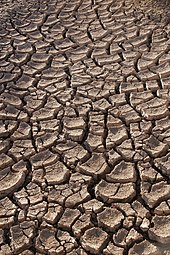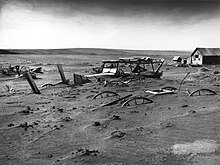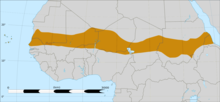WHAT IS DROUGHT ?
INTRODUCTION:
For other uses, see Drought (disambiguation).

Dry earth in the Sonoran desert, Mexico.
Many plant species, such as cacti, have adaptations such as reduced leaf area and waxy cuticles to enhance their ability to tolerate drought. Some others survive dry periods as buried seeds. Semi-permanent drought produces arid biomes such as deserts and grasslands.[4] Most arid ecosystems have inherently low productivity.
Contents
Consequences

A Mongolian gazelle dead due to drought.
Drought can also reduce water quality, because lower water flows reduce dilution of pollutants and increase contamination of remaining water sources. Common consequences of drought include:
- Diminished crop growth or yield productions and carrying capacity for livestock
- Dust bowls, themselves a sign of erosion, which further erode the landscape
- Dust storms, when drought hits an area suffering from desertification and erosion
- Famine due to lack of water for irrigation
- Habitat damage, affecting both terrestrial and aquatic wildlife[5]
- Hunger, drought provides too little water to support food crops.
- Malnutrition, dehydration and related diseases
- Mass migration, resulting in internal displacement and international refugees
- Reduced electricity production due to reduced water flow through hydroelectric dams[6]
- Shortages of water for industrial users[7][8]
- Snake migration, which results in snakebites[9]
- Social unrest
- War over natural resources, including water and food
- Wildfires, such as Australian bushfires, are more common during times of drought and even death of people.[10]
Globally
Drought is a normal, recurring feature of the climate in most parts of the world. It is among the earliest documented climatic events, present in the Epic of Gilgamesh and tied to the biblical story of Joseph's arrival in and the later Exodus from Ancient Egypt.[11] Hunter-gatherer migrations in 9,500 BC Chile have been linked to the phenomenon,[12] as has the exodus of early humans out of Africa and into the rest of the world around 135,000 years ago.[13]
A South Dakota farm during the Dust Bowl, 1936
Examples
Main page: :Category:Droughts
Well-known historical droughts include:- 1900 India killing between 250,000 to 3.25 million.
- 1921-22 Soviet Union in which over 5 million perished from starvation due to drought
- 1928-30 Northwest China resulting in over 3 million deaths by famine.
- 1936 and 1941 Sichuan Province China resulting in 5 million and 2.5 million deaths respectively.
- The 1997-2009 Millenium Drought in Australian led to a water supply crisis across much of the country. As a result many desalination plants were built for the first time (see list).
- In 2006, Sichuan Province China experienced its worst drought in modern times with nearly 8 million people and over 7 million cattle facing water shortages.
- 12-year drought that was devastating southwest Western Australia, southeast South Australia, Victoria and northern Tasmania was "very severe and without historical precedent".
- In 2011, the State of Texas lived under a drought emergency declaration for the entire calendar year. The drought caused the Bastrop fires.
Approximately 2.4 billion people live in the drainage basin of the Himalayan rivers.[15] India, China, Pakistan, Bangladesh, Nepal and Myanmar could experience floods followed by droughts in coming decades. Drought in India affecting the Ganges is of particular concern, as it provides drinking water and agricultural irrigation for more than 500 million people.[16][17][18] The west coast of North America, which gets much of its water from glaciers in mountain ranges such as the Rocky Mountains and Sierra Nevada, also would be affected.[19][20]

Affected areas in the western Sahel belt during the 2012 drought.
By far the largest part of Australia is desert or semi-arid lands commonly known as the outback. A 2005 study by Australian and American researchers investigated the desertification of the interior, and suggested that one explanation was related to human settlers who arrived about 50,000 years ago. Regular burning by these settlers could have prevented monsoons from reaching interior Australia.[26] In June 2008 it became known that an expert panel had warned of long term, maybe irreversible, severe ecological damage for the whole Murray-Darling basin if it did not receive sufficient water by October 2008.[27] Australia could experience more severe droughts and they could become more frequent in the future, a government-commissioned report said on July 6, 2008.[28] Australian environmentalist Tim Flannery, predicted that unless it made drastic changes, Perth in Western Australia could become the world’s first ghost metropolis, an abandoned city with no more water to sustain its population.[29] The long Australian Millennial drought broke in 2010.
Recurring droughts leading to desertification in East Africa have created grave ecological catastrophes, prompting food shortages in 1984-1985, 2006 and 2011.[30] During the 2011 drought, an estimated 50,000 to 150,000 people were reported to have died,[31] though these figures and the extent of the crisis are disputed.[32] In February 2012, the UN announced that the crisis was over due to a scaling up of relief efforts and a bumper harvest.[33] Aid agencies subsequently shifted their emphasis to recovery efforts, including digging irrigation canals and distributing plant seeds.[33]
In 2012, a severe drought struck the western Sahel. The Methodist Relief & Development Fund (MRDF) reported that more than 10 million people in the region were at risk of famine due to a month long heat wave that was hovering over Niger, Mali, Mauritania and Burkina Faso. A fund of about £20,000 was distributed to the drought-hit countries.[34]
Causes
Generally, rainfall is related to the amount and dew point (determined by air temperature) of water vapour carried by regional atmosphere, combined with the upward forcing of the air mass containing that water vapour. If these combined factors do not support precipitation volumes sufficient to reach the surface, the result is a drought. This can be triggered by high level of reflected sunlight, (high albedo), and above average prevalence of high pressure systems, winds carrying continental, rather than oceanic air masses (i.e. reduced water content), and ridges of high pressure areas from behaviors which prevent or restrict the developing of thunderstorm activity or rainfall over one certain region. Oceanic and atmospheric weather cycles such as the El Niño-Southern Oscillation (ENSO) make drought a regular recurring feature of the Americas along the Midwest and Australia. Guns, Germs, and Steel author Jared Diamond sees the stark impact of the multi-year ENSO cycles on Australian weather patterns as a key reason that Australian aborigines remained a hunter-gatherer society rather than adopting agriculture.[35] Another climate oscillation known as the North Atlantic Oscillation has been tied to droughts in northeast Spain.[36]Human activity can directly trigger exacerbating factors such as over farming, excessive irrigation,[37] deforestation, and erosion adversely impact the ability of the land to capture and hold water.[38] While these tend to be relatively isolated in their scope, activities resulting in global climate change are expected to trigger droughts with a substantial impact on agriculture[39] throughout the world, and especially in developing nations.[40][41][42] Overall, global warming will result in increased world rainfall.[43] Along with drought in some areas, flooding and erosion will increase in others. Paradoxically, some proposed solutions to global warming that focus on more active techniques, solar radiation management through the use of a space sunshade for one, may also carry with them increased chances of drought.[44]
Types
As a drought persists, the conditions surrounding it gradually worsen and its impact on the local population gradually increases. People tend to define droughts in three main ways:[45]- Meteorological drought is brought about when there is a prolonged period with less than average precipitation. Meteorological drought usually precedes the other kinds of drought.
- Agricultural droughts are droughts that affect crop production or the ecology of the range. This condition can also arise independently from any change in precipitation levels when soil conditions and erosion triggered by poorly planned agricultural endeavors cause a shortfall in water available to the crops. However, in a traditional drought, it is caused by an extended period of below average precipitation.
- Hydrological drought is brought about when the water reserves available in sources such as aquifers, lakes and reservoirs fall below the statistical average. Hydrological drought tends to show up more slowly because it involves stored water that is used but not replenished. Like an agricultural drought, this can be triggered by more than just a loss of rainfall. For instance, Kazakhstan was recently awarded a large amount of money by the World Bank to restore water that had been diverted to other nations from the Aral Sea under Soviet rule.[46] Similar circumstances also place their largest lake, Balkhash, at risk of completely drying out.[47]
Protection and relief

Water distribution on Marshall Islands during El Niño.
- Dams - many dams and their associated reservoirs supply additional water in times of drought.
- Cloud seeding - a form of intentional weather modification to induce rainfall.[48]
- Desalination - of sea water for irrigation or consumption.
- Drought monitoring - Continuous observation of rainfall levels and comparisons with current usage levels can help prevent man-made drought. For instance, analysis of water usage in Yemen has revealed that their water table (underground water level) is put at grave risk by over-use to fertilize their Khat crop.[49] Careful monitoring of moisture levels can also help predict increased risk for wildfires, using such metrics as the Keetch-Byram Drought Index[10] or Palmer Drought Index.
- Land use - Carefully planned crop rotation can help to minimize erosion and allow farmers to plant less water-dependent crops in drier years.
- Outdoor water-use restriction - Regulating the use of sprinklers, hoses or buckets on outdoor plants, filling pools, and other water-intensive home maintenance tasks.
- Rainwater harvesting - Collection and storage of rainwater from roofs or other suitable catchments.
- Recycled water - Former wastewater (sewage) that has been treated and purified for reuse.
- Transvasement - Building canals or redirecting rivers as massive attempts at irrigation in drought-prone areas.

Aerosols over the Amazon each September for four burning seasons (2005 through 2008) during the Amazon basin drought. The aerosol scale (yellow to dark reddish-brown) indicates the relative amount of particles that absorb sunlight.
Dry areas
-
Fields outside Benambra, Victoria, Australia suffering from drought conditions.
-
Sheep on a drought affected paddock near Uranquinty, New South Wales.
See also
- Aridity index
- Climate change
- Collapse: How Societies Choose to Fail or Succeed
- Drought refuge
- FEMA
- Food security
- Permanent wilting point
- Topsoil
- United Nations Convention to Combat Desertification
- Water conflict
- Water crisis
External links
| Wikimedia Commons has media related to Drought. |
| Look up drought in Wiktionary, the free dictionary. |
| Wikibooks has more on the topic of: Drought |
- GIDMaPS Global Integrated Drought Monitoring and Prediction System, University of California, Irvine
- Water scarcity from FAO Water (Food and Agriculture Organization of the United Nations)
- Drought: Hearing before the Committee on Energy and Natural Resources, United States Senate, One Hundred Thirteenth Congress, First Session, on Exploring the Effects of Drought on Energy And Water Management, April 25, 2013
|
||||||||||||||||||||||||||||||||||||||||||||||||||||||
| ||
|
||







No comments:
Post a Comment